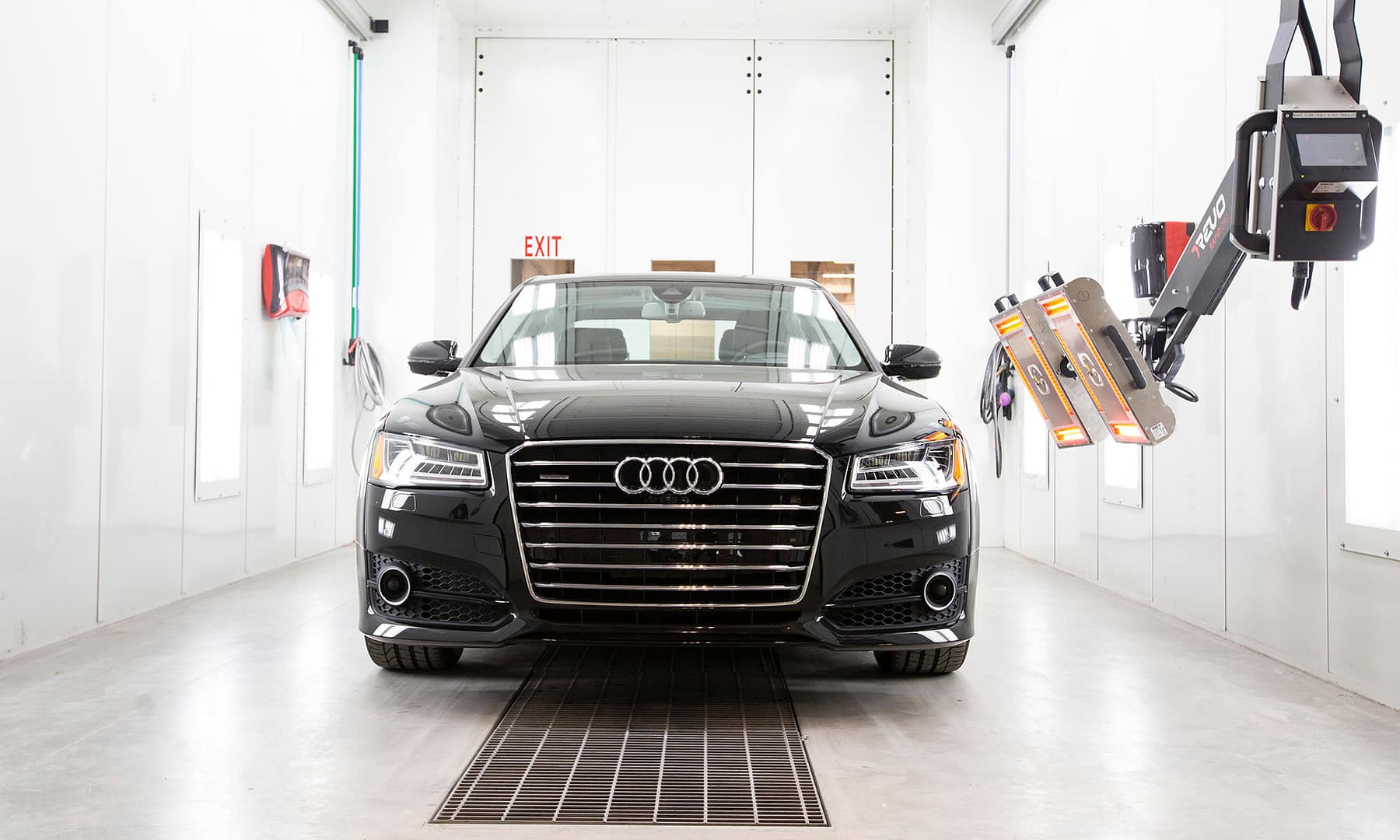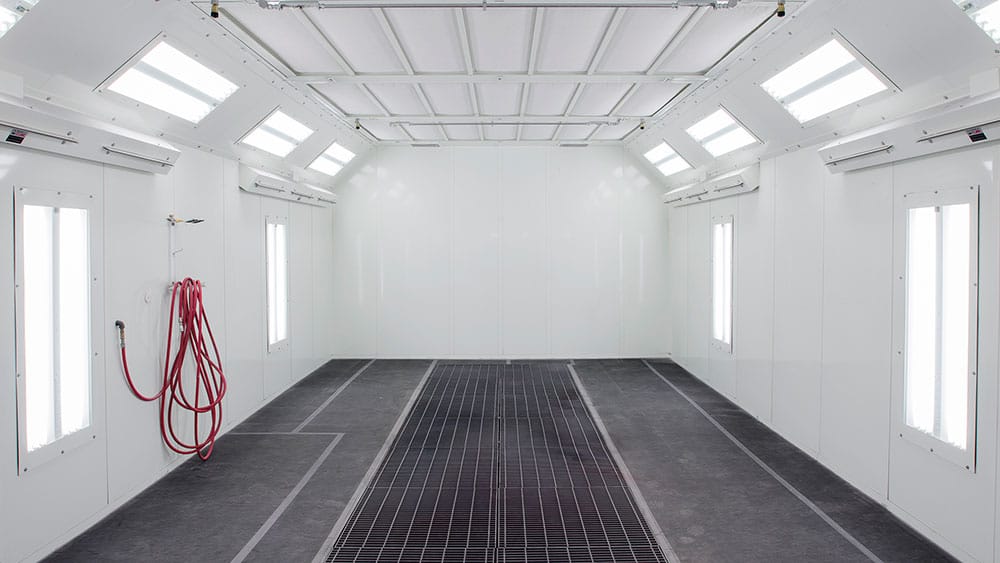
New technology is flooding the collision repair industry — all in the name of improving quality and increasing throughput, with the potential for additional profit. However, the first step in this direction is to select the right equipment for your shop.
There are many types of equipment that directly impact the number of booth cycles a shop can perform, affecting your shop’s bottom line. Shops can increase throughput with no additional labor by selecting the right equipment, streamlining the layout and allowing room to maneuver as technology evolves.
The size of the building should be the main consideration for body shop owners debating an equipment upgrade. Modifying your shop’s layout or upgrading your equipment is an option if your shop does not have room to expand but needs to get more vehicles through. A good way to boost efficiency at a minimal expense with minor changes to your layout is to add a drive-thru configuration to a booth. Adding drive-thru doors to a paint booth allows a vehicle to be staged while another is being painted.
Also important is the type of curing equipment your shop uses. A solvent-based basecoat will dry quickly on its own. Meanwhile, accelerated curing via infrared lamps, extra heat from a booth’s cure cycle or blowers speed up the drying process for waterborne paint.
A standard collision repair facility should be able to produce three to five vehicles in an eight-hour shift with one semi-downdraft spray booth. Precise use of space inside and outside the paint booth is needed to finish five vehicles in one day with a semi-downdraft booth, offering little-to-no room for error. Shops with a downdraft spray booth, on the other hand, can produce four to six vehicles a day, providing less obstacles for painters, increased quality for customers and additional growth opportunities for shop owners.
In a semi-downdraft spray booth, painters must be more conscious of overspray. When painting in the front of a semi-downdraft spray booth, overspray drifts over the vehicle to the exhaust filters at the rear of the paint booth. Overspray could contaminate parts in the booth, meaning if there is a full booth load, painters may not be able to spray more than one color at once.

In downdraft spray booths, the flow of air offers excellent overspray and contamination control, resulting in cleaner paint jobs. Overspray is directed downward through a filtered exhaust pit in the floor, regardless of where you are painting in a downdraft spray booth, making it easier to spray multiple colors at once. More upgrade options are also possible with downdraft paint booths, such as an expanded exhaust pit, to enhance airflow downward.

Prep time is also much longer with a semi-downdraft spray booth than a downdraft spray booth. Plastic must be taped around the entire vehicle before painting with a semi-downdraft booth, to withstand the airflow in the paint booth. Technicians can just place the plastic on the car or part in a downdraft booth; there is no need to tape it around the entire vehicle, as the downward airflow draws the plastic tight to the vehicle. Plastic around the parts of the vehicle being painted simply need to be cut out so the parts are exposed.
While downdraft spray booths are best suited for high-production shops, semi-downdraft booths might be the best option for restoration shops. A top-of-the-line downdraft booth is probably more of a luxury than a necessity for restoration businesses, since they do not usually have as tight of deadlines as collision repair facilities. Restoration shops should also consider purchasing an oversized paint booth for larger jobs, as they often paint full bodies of vehicles, including roofs of vans and trucks.
Production can be increased by one additional vehicle per week when shops select the right equipment and accessories to improve efficiency, which can pay off big time. Since an average U.S. work order for a body shop is around $3,000, this translates to $1,200 of gross profit per vehicle when factored at an industry standard of 40 percent. Processing one more vehicle per week at that rate will equal $4,800 more per month and $62,400 more per year of gross profit.
A Side-Load System can be a game-changer for body shops looking to prevent a backlog. Vehicles move quickly between work bays on an integrated track-and-dolly system, creating improved productivity and maximized shop space. All masking can be done outside the paint booth since vehicles do not need to be driven into the booth, saving 15 to 30 minutes per booth cycle. As opposed to the typical four to six, downdraft paint booths with a Side-Load System can process up to eight vehicles per day, equating to an average of $9,600 more per month and $124,800 more per year of gross profit.
If shop space permits, adding a Side-Load System to a downdraft spray booth is also much cheaper than purchasing a second paint booth. Side-Load Systems are most beneficial for businesses with a high volume of light repairs, such as shops with quick lane service models and used car refurbishment centers.
Combining Side-Load Systems with accelerated drying systems, such as AdvanceCure® Accelerated Airflow Systems from Global Finishing Solutions (GFS), maximizes efficiency for shops. The transfer of heat from the air to the painted panels is dramatically improved as the AdvanceCure System introduces turbulent airflow into the paint booth. The fast basecoat application is one of the biggest benefits of an accelerated drying system. Most shops have to wait 20 to 30 minutes for the paint to dry with a waterborne wet-on-wet basecoat system. That time is cut in half with an accelerated drying system. The AdvanceCure System can be added to a new GFS paint booth or retrofitted into most existing paint booth models.
Electric infrared curing systems, such as REVO Accelerated Curing Systems from GFS, offer another proven way to increase paint shop throughput without increasing your shop’s footprint. REVO Systems quickly cure filler and coatings from the inside out with short wave electric infrared technology, reducing curing time to only minutes. Most shops with REVO Systems, one prep station and one paint booth can process up to 12 vehicles a day, increasing throughput by up to 80 percent.
An affordable non-pressurized paint booth, such as a Performer® ES Paint Booth from GFS, is a good fit for small- and medium-sized shops trying to stay within a smaller budget for new equipment. This booth provides a dependable, all-in-one painting environment, with the ease of adding a heater down the road.
For shops that are projecting future growth, but cannot currently accommodate more volume, an option is an Ultra® XR Paint Booth from GFS, minus the integrated REVO System. This downdraft paint booth features an extended interior height to install a REVO Speed or Rapid, which can be added when the time is right, along with pressurized power rails.
The equipment you purchase today sets up your shop for growth and better profit margins tomorrow. By processing only one more vehicle per week, a shop can usually recoup its equipment investment in less than a year. Now is the best time for shop owners to purchase better equipment to position themselves for the future.
One of the best ways to highlight your business is through a story that you can share across your online platforms. It humanizes your business and shows that your business can make a meaningful impact. Your testimonial would be used as a project profile on the GFS Booth Blog and can be shared on your website and/or social media channels.
Complete this form and we’ll be in touch to showcase your company.

Shop a variety of GFS aftermarket products, including booth protection products and mobile accelerated curing units. And enjoy the convenience of fast and free ground shipping throughout the contiguous United States.

Located at GFS’ headquarters in Osseo, Wisconsin, the Center for Excellence is an innovative facility featuring an automotive refinish training center, as well as a separate space dedicated to technical product training.

GFS is continuously searching for talented, ambitious individuals to join our team. We aim to provide our employees with every opportunity to make an impact on the company and find their niche along the way — weather in a production, field services or an office position.